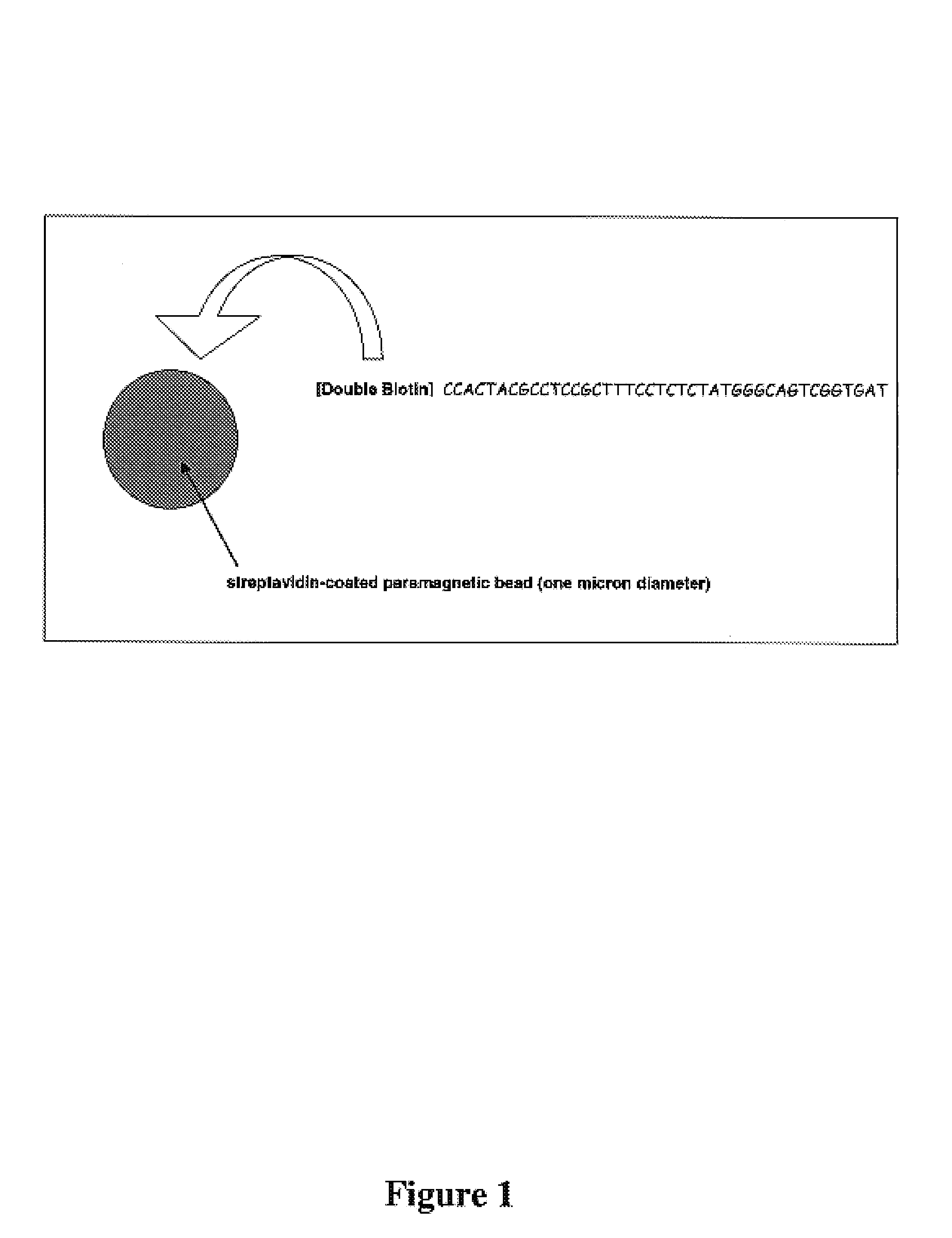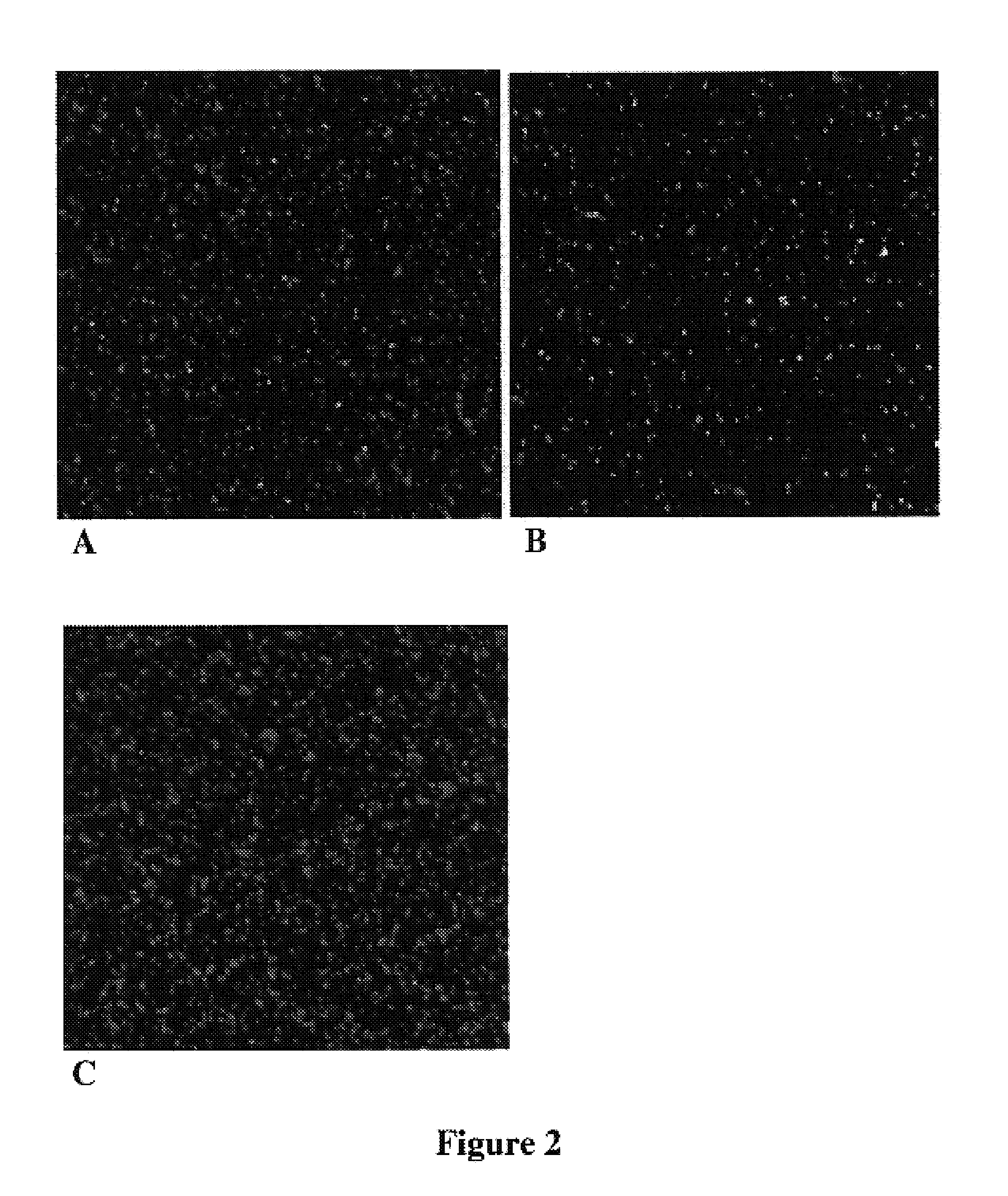Polony fluorescent in situ sequencing beads
a polygony fluorescent and in situ sequencing technology, applied in the field of minimalized, high density, bead-based arrays, can solve the problems of low throughput, high cost of operation, and many drawbacks of methods, and achieve the effect of efficient, cost-effective production of bead-based arrays
- Summary
- Abstract
- Description
- Claims
- Application Information
AI Technical Summary
Benefits of technology
Problems solved by technology
Method used
Image
Examples
example i
Clonal Beads
Step 1: Coupling Oligonucleotides to Beads
[0061]Commercially available oligonucleotides obtained from Integrated DNA Technologies were used (Coralville, Iowa). The oligonucleotides were attached to streptavidin-coated paramagnetic beads (1 μM MYONE™ beads (Dynal Biotech, Brown Deer, Wis.)) via the double-biotin moieties at their 5′ ends (FIG. 1). The sequence of the oligonucleotide was identical to the PR1-F section of the library molecules described in the library generation protocol below (Example VI). Subsequent to this step, this allows the bead-immobilized oligonucleotide to act as a PCR primer during amplification of a template library as described herein. In the protocols described herein, this sequence is referred to as the ‘forward’ PCR primer.
[0062]Steps for generating forward-primer-loaded beads were as follows:[0063]1) Using a magnetic field to the pull beads to the side of a microcentrifuge tube, 1×109 MYONE™ Streptavidin paramagnetic beads (100 μL of stock ...
example ii
Enrichment of Beads
[0123]The following protocol can be used to separate empty beads from clonal beads. The combined use of a low template concentration in the emulsion PCR reaction and the enrichment protocol resulted in a higher fraction of ‘clonally amplified’ beads than would otherwise be possible. The basis for enrichment was the use of a second set of large (3 micron diameter), non-magnetic beads (i.e., ‘capture beads’) that included a primer having a sequence identical to the ‘reverse’ PCR primer sequence (PR1-R). As sequence complementary to the reverse PCR primer will only be present on strands of DNA that are the product of the PCR reaction, amplified beads selectively hybridized to these large capture beads, whereas empty beads did not hybridize to capture beads efficiently. The 3 micron capture beads, hybridized to 1 micron amplified beads, were separated from the 1 micron empty beads on the basis of their differential density (e.g., by centrifuging beads through a densit...
example iii
Monolayers of Disordered, Immobilized Beads
[0128]The critical nature of monolayering can be understood in the context of the depth of field of high resolution microscopes. For example, the depth of field with a 20× Plan Apo (NA=0.75) objective, one of the best commercially available objectives in terms of resolution is 1.9 microns. When clonal microspheres are only one micron in diameter, significant deviations from a monolayer would thus result in an inability to image arrayed beads while maintaining focus on all beads within a given field of view.
[0129]The following steps could take place before or after amplification (e.g., by a method for making populations of clonal microspheres), and optionally, after the bead enrichment protocol had been performed. Parallel sequencing or other forms of cyclic nucleic acid analysis would be carried out after the beads had been monolayered.
[0130]To form a monolayers of beads, the following protocol was used. The following reagents were mixed: 3...
PUM
| Property | Measurement | Unit |
|---|---|---|
| diameter | aaaaa | aaaaa |
| diameter | aaaaa | aaaaa |
| diameter | aaaaa | aaaaa |
Abstract
Description
Claims
Application Information
 Login to View More
Login to View More - R&D
- Intellectual Property
- Life Sciences
- Materials
- Tech Scout
- Unparalleled Data Quality
- Higher Quality Content
- 60% Fewer Hallucinations
Browse by: Latest US Patents, China's latest patents, Technical Efficacy Thesaurus, Application Domain, Technology Topic, Popular Technical Reports.
© 2025 PatSnap. All rights reserved.Legal|Privacy policy|Modern Slavery Act Transparency Statement|Sitemap|About US| Contact US: help@patsnap.com



